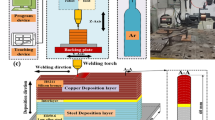Conclusions
-
1.
Stainless steel cladding, which has a lower thermal conductivity, substantially lowers the cooding rate during quenching of two-layer steel.
-
2.
Bonding defects have dual effects on the hardenability, reducing it somewhat because of the lower cooling rate but at the same time increasing it by limiting the degree of decarburization of the base metal near the stainless steel cladding layer.
-
3.
In selecting the base metal for heat treated bimetals and the production technology (heat treatment of single or double sheets) one must take into consideration the reduced hardenability due to the stainless steel cladding.
Similar content being viewed by others
Literature cited
B. G. Livshits, Physical Properties of Metals and Alloys [in Russian], Mashgiz (1959).
S. A. Gladyrevskaya, L. V. Meandrov, S. A. Golovanenko, and A. A. Bykov, Two-Layer Steels in Chemical Machine Construction [in Russian], Mashinostroenie (1965).
Additional information
Translated from Metallovednie i Termicheskaya Obrabotka Metallov, No. 3, pp. 70–72, March, 1968.
Rights and permissions
About this article
Cite this article
Dontsov, P.M., Shevbunov, E.V. & Pavlenko, N.T. Effect of stainless steel caldding on the hardenability of the base metal in thermally improved two-layer steel. Met Sci Heat Treat 10, 231–233 (1968). https://doi.org/10.1007/BF00666873
Issue Date:
DOI: https://doi.org/10.1007/BF00666873




